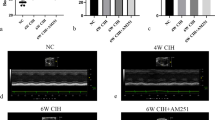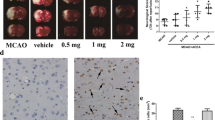Abstract
Delta-9-tetrahydrocannabinol (THC), the major active component of marijuana, has a beneficial effect on the cardiovascular system during stress conditions, but the defence mechanism is still unclear. The present study was designed to investigate the central (CB1) and the peripheral (CB2) cannabinoid receptor expression in neonatal cardiomyoctes and possible function in the cardioprotection of THC from hypoxia. Pre-treatment of cardiomyocytes that were grown in vitro with 0.1 – 10 μM THC for 24 h prevented hypoxia-induced lactate dehydrogenase (LDH) leakage and preserved the morphological distribution of α-sarcomeric actin. The antagonist for the CB2 (10 μM), but not CB1 receptor antagonist (10 μM) abolished the protective effect of THC. In agreement with these results using RT-PCR, it was shown that neonatal cardiac cells express CB2, but not CB1 receptors. Involvement of NO in the signal transduction pathway activated by THC through CB2 was examined. It was found that THC induces nitric oxide (NO) production by induction of NO synthase (iNOS) via CB2 receptors. L-NAME (NOS inhibitor, 100 μM) prevented the cardioprotection provided by THC. Taken together, our findings suggest that THC protects cardiac cells against hypoxia via CB2 receptor activation by induction of NO production. An NO mechanism occurs also in the classical pre-conditioning process; therefore, THC probably pre-trains the cardiomyocytes to hypoxic conditions.
Similar content being viewed by others
References
Sarafian TA, Kouyoumjian S, Tashkin D, Roth MD: Synergistic cytotoxicity of Delta(9)-tetrahydrocannabinol and butylated hydroxyanisole. Toxicol Lett 133: 171–179, 2002
Nahas G: Marihuana in Science and Medicine. Raven, New York, 1984
Ross SA, Elsohly MA: Constituents of Cannabis sativa L. XXVIII. A review of the natural constituents:1980–1994. Zagazig J Pharmacol Sci 4: 1–10, 1995
Jones RT: Cardiovascular system effects of marijuana. J Clin Pharmacol 42: 58S–63S, 2002
McLendon DM, Harris RT, Maule WF: Suppression of the cardiac-conditioned response by delta-9-tetrahydrocannabinol: A comparison with other drugs. Psychopharmacology (Berl) 50: 159–163, 1976
Sidney S: Cardiovascular consequences of marijuana use. J Clin Pharmacol 42: 64S–70S, 2002
Matsuda LA, Lolait SJ, Brownstein MJ, Young AC, Bonner TI: Structure of a cannabinoid receptor and functional expression of the cloned cDNA. Nature 346: 561–564, 1990
Munro S, Thomas KL, Abu-Shaar M: Molecular characterization of a peripheral receptor for cannabinoids. Nature 365: 61–65, 1993
Bachs L, Morland H: Acute cardiovascular fatalities following cannabis use. Forensic Sci Int 124: 200–203, 2001
Benowitz NL, Jones RT: Cardiovascular and metabolic considerations in prolonged cannabinoid administration in man. J Clin Pharmacol 21: 214S–223S, 1981
Akins D, Awdeh MR: Marijuana and second-degree AV block. South Med J 74: 371–373, 1981
Krylatov AV, Bernatskaia NA, Maslov LN, Pertwee RG, Mechoulam R, Stefano GB, Sharaevskii MA, Sal'nikova OM: Increase of the heart arrhythmogenic resistance and decrease of the myocardial necrosis zone during activation of cannabinoid receptors. Ross Fiziol Zh Im I M Sechenova 88: 560–567, 2002
Joyeux M, Arnaud C, Godin-Ribuot D, Demenge P, Lamontagne D, Ribuot C: Endocannabinoids are implicated in the infarct size-reducing effect conferred by heat stress pre-conditioning in isolated rat hearts. Cardiovasc Res 55: 619–625, 2002
Bolli R: Cardioprotective function of inducible nitric oxide synthase and role of nitric oxide in myocardial ischemia and pre-conditioning: An overview of a decade of research. J Mol Cell Cardiol 33: 1897–1918, 2001
Brik H, Shainberg A: Thyroxine induces transition of red towards white muscle in cultured heart cells. Basic Res Cardiol 85: 237–246, 1990
Shneyvays V, Mamedova L, Zinman T, Jacobson K, Shainberg A: Activation of A3 adenosine receptor protects against doxorubicin-induced cardiotoxicity. J Mol Cell Cardiol 33: 1249–1261, 2001
Shneyvays V, Mamedova LK, Korkus A, Shainberg A: Cardiomyocyte resistance to Doxorubicin mediated by A3 adenosine receptor. J Mol Cell Cardiol 34: 493–507, 2002
Shainberg A, Safran N, Balas N, Zinman T, Isaac A, Schwab K, Akabayov B, Shneyvays V: The role of A1/A3 adenosine receptor activation in reduction of cardiomyocyte injury caused by hypoxic stress and in induction of apoptosis in rat cardiomyocyte cultures. Adv Exp Med Biol 486: 201–205, 2000
Bradford MM: A rapid and sensitive method for the quantitation of microgram quantities of protein utilizing the principle of protein dye binding. Anal Biochem 72: 248–254, 1976
Shneyvays V, Nawrath H, Jacobson KA, Shainberg A: Induction of apoptosis in cardiac myocytes by an A3 adenosine receptor agonist. Exp Cell Res 243: 383–397, 1998
Palmer RM, Ferrige AG, Moncada S: Nitric oxide release accounts for the biological activity of endothelium-derived relaxing factor. Nature 327: 524–526, 1987
Jarai Z, Wagner JA, Varga K, Lake KD, Compton DR, Martin BR, Zimmer AM, Bonner TI, Buckley NE, Mezey E, Razdan RK, Zimmer A, Kunos G: Cannabinoid-induced mesenteric vasodilation through an endothelial site distinct from CB1 or CB2 receptors. Proc Natl Acad Sci USA 96: 14136–14141, 1999
Neidhart JA, Gagen MM, Wilson HE, Young DC: Comparative trial of the antiemetic effects of THC and haloperidol. J Clin Pharmacol 21: 38S–42S, 1981
Randall RC: Cancer Treatment and Marijuana Therapy. Galen, 1990
Randall RC: Marijuana and AIDS: Pot, Politics and PWAs in America. Galen, 1991
Bagshaw SM, Hagen NA: Medical efficacy of cannabinoids and marijuana: a comprehensive review of the literature. J Palliat Care 18: 111–122, 2002
Merritt JC, Perry DD, Russell DN, Jones BF: Topical delta 9-tetrahydrocannabinol and aqueous dynamics in glaucoma. J Clin Pharmacol 21: 467S–471S, 1981
Downer E, Boland B, Fogarty M, Campbell V: Delta 9-tetrahydrocannabinol induces the apoptotic pathway in cultured cortical neurones via activation of the CB1 receptor. Neuroreport 12: 3973–3978, 2001
Galve-Roperh I, Sanchez C, Cortes ML, del Pulgar TG, Izquierdo M, Guzman M: Anti-tumoural action of cannabinoids: involvement of sustained ceramide accumulation and extracellular signal-regulated kinase activation. Nat Med 6: 313–319, 2000
Sanchez C, Galve-Roperh I, Canova C, Brachet P, Guzman M: Delta9-tetrahydrocannabinol induces apoptosis in C6 glioma cells. FEBS Lett 436: 6–10, 1998
Sarafian TA, Tashkin DP, Roth MD: Marijuana smoke and Delta(9)-tetrahydrocannabinol promote necrotic cell death but inhibit Fas-mediated apoptosis. Toxicol Appl Pharmacol 174: 264–272, 2001
Shneyvays V, Leshem D, Shmist Y, Zinman T, Shainberg A: Effects of menadione and its derivative on cultured cardiomyocytes with mitochondrial disorders. J Mol Cell Cardiol 39: 149–158, 2005
Galiegue S, Mary S, Marchand J, Dussossoy D, Carriere D, Carayon P, Bouaboula M, Shire D, Le Fur G, Casellas P: Expression of central and peripheral cannabinoid receptors in human immune tissues and leukocyte subpopulations. Eur J Biochem 232: 54–61, 1995
Rice W, Shannon JM, Burton F, Fiedeldey D: Expression of a brain-type cannabinoid receptor (CB1) in alveolar Type II cells in the lung: regulation by hydrocortisone. Eur J Pharmacol 327: 227–232, 1997
Schatz AR, Lee M, Condie RB, Pulaski JT, Kaminski NE: Cannabinoid receptors CB1 and CB2: a characterization of expression and adenylate cyclase modulation within the immune system. Toxicol Appl Pharmacol 142: 278–287, 1997
Klein C: Nitric oxide and the other cyclic nucleotide. Cell Signal 14: 493–498, 2002
Fischer EH, Pocker A, Saari JC: The structure, function and control of glycogen phosphorylase. Essays Biochem 6: 23–68, 1970
Schulze PC, Gielen S, Schuler G, Hambrecht R: Chronic heart failure and skeletal muscle catabolism: effects of exercise training. Int J Cardiol 85: 141–149, 2002
Shiono N, Rao V, Weisel RD, Kawasaki M, Li RK, Mickle DA, Fedak PW, Tumiati LC, Ko L, Verma S: L-arginine protects human heart cells from low-volume anoxia and reoxygenation. Am J Physiol 282: H805–H815, 2002
Ockaili R, Emani VR, Okubo S, Brown M, Krottapalli K, Kukreja RC: Opening of mitochondrial KATP channel induces early and delayed cardioprotective effect: role of nitric oxide. Am J Physiol 277: H2425–H2434, 1999
Garlid KD, Dos Santos P, Xie ZJ, Costa AD, Paucek P: Mitochondrial potassium transport: the role of the mitochondrial ATP-sensitive K(+) channel in cardiac function and cardioprotection. Biochim Biophys Acta 1606: 1–21, 2003
Cohen G, Shirai T, Weisel RD, Rao V, Merante F, Tumiati LC, Mohabeer MK, Borger MA, Li RK, Mickle DA: Optimal myocardial pre-conditioning in a human model of low-volume ischemia and reperfusion. Circulation. 98(19 Suppl): II184-II194, 1998
Author information
Authors and Affiliations
Corresponding author
Rights and permissions
About this article
Cite this article
Shmist, Y.A., Goncharov, I., Eichler, M. et al. Delta-9-tetrahydrocannabinol protects cardiac cells from hypoxia via CB2 receptor activation and nitric oxide production. Mol Cell Biochem 283, 75–83 (2006). https://doi.org/10.1007/s11010-006-2346-y
Received:
Accepted:
Issue Date:
DOI: https://doi.org/10.1007/s11010-006-2346-y




